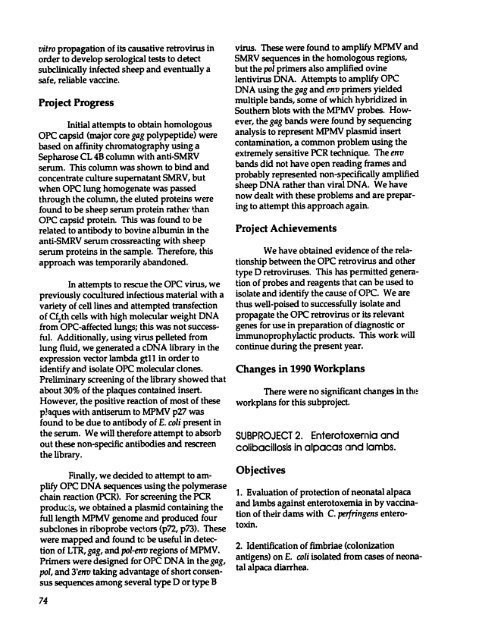Research Results - (PDF, 101 mb) - USAID
Research Results - (PDF, 101 mb) - USAID
Research Results - (PDF, 101 mb) - USAID
You also want an ePaper? Increase the reach of your titles
YUMPU automatically turns print PDFs into web optimized ePapers that Google loves.
vitro propagation of its causative retrovirus in<br />
order to develop serological tests to detect<br />
subclinically infected sheep and eventually a<br />
safe, reliable vaccine.<br />
Project Progress<br />
Initial attempts to obtain homologous<br />
OPC capsid (major core gag polypeptide) were<br />
based on affinity chromatography using a<br />
Sepharose CL 4B column with anti-SMRV<br />
serum. This column was shown to bind and<br />
concentrate culture supernatant SMRV, but<br />
when OPC lung homogenate was passed<br />
through the column, the eluted proteins were<br />
found to be sheep serum protein rather than<br />
OPC capsid protein. This was found to be<br />
related to antibody to bovine albumin in the<br />
anti-SMRV serum crossreacting with sheep<br />
serum proteins in the sample. Therefore, this<br />
approach was temporarily abandoned.<br />
In attempts to rescue the OPC virus, we<br />
previously cocultured infectious material with a<br />
variety of cell lines and attempted transfection<br />
of Cf2th cells with high molecular weight DNA<br />
from OPC-affected lungs; this was not successful.<br />
Additionally, using virus pelleted from<br />
lung fluid, we generated a cDNA library in the<br />
expression vector la<strong>mb</strong>da gtl1 in order to<br />
identify and isolate OPC molecular clones.<br />
Preliminary screening of the library showed that<br />
about 30% of the plaques contained insert.<br />
However, the positive reaction of most of these<br />
p!aques with antiserum to MPMV p27 was<br />
found to be due to antibody of E.coli present in<br />
the serum. We will therefore attempt to absorb<br />
out these non-specific antibodies and rescreen<br />
the library.<br />
Finally, we decided to attempt to amplify<br />
OPC DNA sequences using the polymerase<br />
chain reaction (PCR). For screening the PCR<br />
producs, we obtained a plasmid containing the<br />
full length MPMV genome and produced four<br />
subclones in riboprobe vectors (p72, p73). These<br />
were mapped and found tc be useful in detection<br />
of LTR, gag, and pol-env regions of MPMV.<br />
Primers were designed for OPC DNA in the gag,<br />
po/, and 3env taking advantage of short consensus<br />
sequences among several type D or type B<br />
74<br />
virus. These were found to amplify MPMV and<br />
SMRV sequences in the homologous regions,<br />
but the pol primers also amplified ovine<br />
lentivirus DNA. Attempts to amplify OPC<br />
DNA using the gag and env primers yielded<br />
multiple bands, some of which hybridized in<br />
Southern blots with the MPMV probes. However,<br />
the gagbands were found by sequencing<br />
analysis to represent MPMV plasmid insert<br />
contamination, a common problem using the<br />
extremely sensitive PCR technique. The env<br />
bands did not have open reading frames and<br />
probably represented non-specifically amplified<br />
sheep DNA rather than viral DNA. We have<br />
now dealt with these problems and are preparing<br />
to attempt this approach again.<br />
Project Achievements<br />
We have obtained evidence of the relationship<br />
between the OPC retrovirus and other<br />
type D retroviruses. This has permitted generation<br />
of probes and reagents that can be used to<br />
isolate and identify the cause of OPC. We are<br />
thus well-poised to successfully isolate and<br />
propagate the OPC retrovirus or its relevant<br />
genes for use in preparation of diagnostic or<br />
immunoprophylactic products. This work will<br />
continue during the present year.<br />
Changes in 1990 Workplans<br />
There were no significant changes in the<br />
workplans for this subproject.<br />
SUBPROJECT 2. Enterotoxemia and<br />
colibacillosis in alpacas and la<strong>mb</strong>s.<br />
Objectives<br />
1. Evaluation of protection of neonatal alpaca<br />
1. luain f protofena alaca<br />
and la<strong>mb</strong>s against enterotoxemia in by vaccination<br />
of their dams with C. perfringens enterotoxin.<br />
2. Identification of fi<strong>mb</strong>riae (colonization<br />
antigens) on E. coli isolated from cases of neonatal<br />
alpaca diarrhea.

















